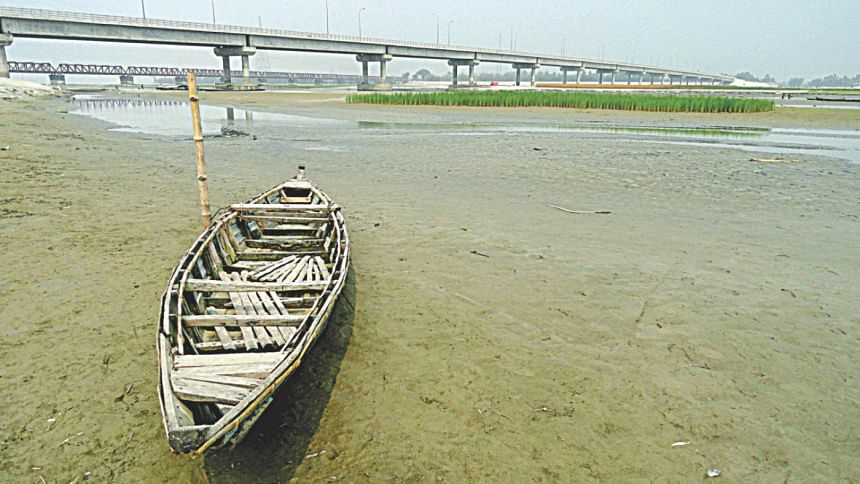Oh, Teesta!

Four years ago, when Bangladesh and India reached an understanding on sharing the Teesta water, people built their hopes up for an increased flow in the shared river.
But soon what they saw in reality dashed their hopes: the much-needed Teesta deal fell through.
In the meantime, with no headway towards signing the deal, the lifeline for millions in the country's northern region kept getting only leaner.
"The Teesta faced the worst ever situation in the last lean period. The entire river went dry this year," said Feroze, convener of Teesta Rakkha Sangram Committee, an organisation working to realise due share of the trans-boundary river.
"Never before in my lifetime did I witness anything as such," said Feroze, who hailed from Purba Kachua village of Gangachara upazila in Rangpur.
A water flow chart obtained from Bangladesh Joint Rivers Commission (JRC) also reflects his account.
The JRC chart shows Bangladesh received only 232 cusecs (cubic feet per second) of Teesta water on March 22, the lowest in history.
The average flow of the Teesta in the last 10 days of March, the peak of the lean period, dropped to 315 cusecs in 2015 from 550 cusecs during the same period in 2014. It was 2,950 cusecs in 2013 and 3,506 cusecs in 2012.
Before the Gazoldoba barrage in India's West Bengal was built, the average flow of the river during the last 10 days of March was 6,710 cusecs between 1973 and 1985.
The water flow statistics shows the water has started reducing in Bangladesh part of the river since the deal was finalised during former Indian prime minister Manmohan Singh's Dhaka tour in September 2011.
However, recent reports published in the Indian media suggest the Modi government is trying to explore the possibility of having a revised Teesta treaty signed.
The Indian newspapers also published different formulas, one of which suggests 46:46 percent sharing of the water between the two countries.
According to the formula, West Bengal has to part with 21 percent of water through Gazoldoba barrage while another 25 percent would be added through regeneration by the time it would reach Dalia barrage.
The Indian media reports also say the federal Indian government is offering financial assistance to West Bengal for developing irrigational infrastructure in the state to use the Teesta water, particularly during the dry season, in a bid to pursue Chief Minister Mamata Banerjee.
Sources point out that even now the state can only use 25 percent of the Teesta waters due to lack of irrigational infrastructure.
However, officials in Bangladesh claim they do not have any clue to any new formulas on the Teesta deal.
"The deal was already been finalised four years ago. Now we are just waiting for the deal to be signed," said a top Bangladeshi official who is involved in the process.
"Now India is dealing with its internal problems," added the official, wishing not to be named.
In 2011, it was finalised that Bangladesh and India would share the water of the Gazoldoba point equally after keeping a certain portion for the river. But the deal could not be signed due to opposition from Mamata.
As the Teesta completely dries up during the lean period, people like boatmen, fishermen and others dependent on the river have meanwhile been forced to change their profession. Farmers are also struggling hard to grow crops, the official said.
Boatman Abdus Samad, 50, of Char Rajpur village in Lalmonirhat Sadar said at least 3,000 boatmen had been unemployed during winter. They had been facing such employment crisis for the last few years, he added.
"Two decades ago when water was abundant in the river around the year, we used to be very busy carrying people and goods from one place to another," he said adding: "But now, many boatmen had already quit their profession.
Jitin Chandra Das, 65, a fisherman of Dashpara village at Aditmari upazila said around 5,000 fishermen like him in 24 villages in the district faced livelihood crisis in winter as they could not catch fish in the river.
"The fishermen are abandoning their ancestral profession every day," he added.
Farmer Nizam Uddin, 55, of Char Gokunda village in Lalmonirhat Sadar said they faced severe irrigational problems due to shortage of water during the lean period.
"We cannot cultivate our land for producing crops as the river dries up around this time of the year," he added.
The underground water level also goes down during the season, making it very difficult for them to pump underground water into the fields, he said.
According to Agriculture Extension Department (AED) officials in Lalmonirhat, no crops can be grown on around 30,000 acres of land in 90 chars and villages in the district during the lean period.
In addition to this, the river without water causes another problem for the char people as they find it hard to walk for miles of sandy land.
Class IX student Sathi Akhter, 14, of Char Dawabari at Hatibandha upazila, said she could not go to school every day in fear of walking two miles on the sand.
"But I attend my classes every day during the monsoon as I can commute on boats then," she said.
Sabuj Khandaker, general secretary of Teesta Putra, a local movement to save the river in Lalmonirhat, said the around-three-kilometre-wide river in the monsoon turned into a 20 to 30-foot wide canal in winter.
"If we can save our Teesta, we can save our agriculture and also save the livelihoods of more than one lakh people living in the shoal areas," he said.

 For all latest news, follow The Daily Star's Google News channel.
For all latest news, follow The Daily Star's Google News channel. 



Comments